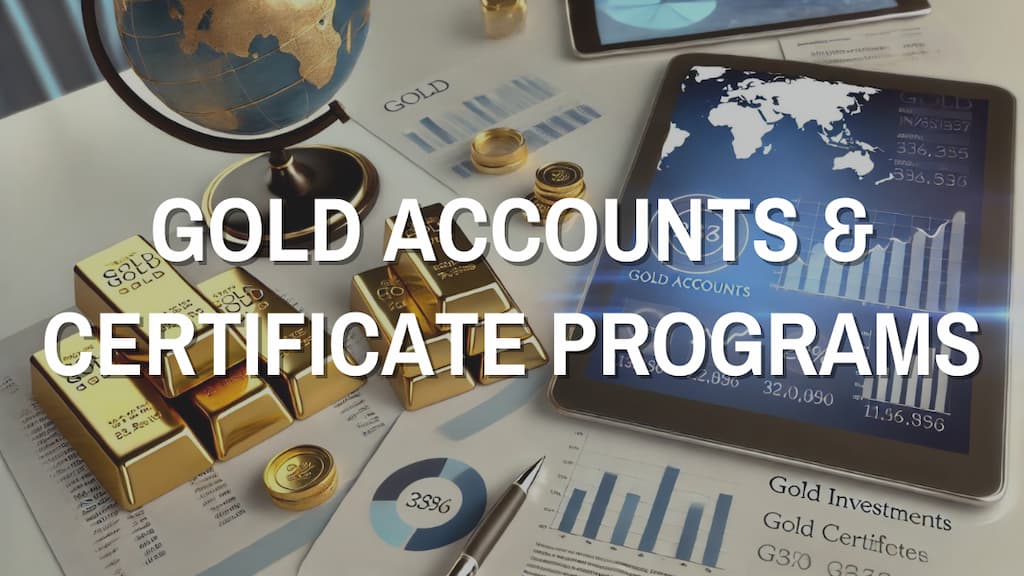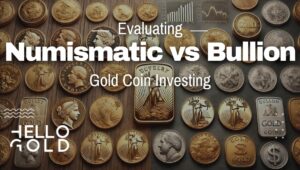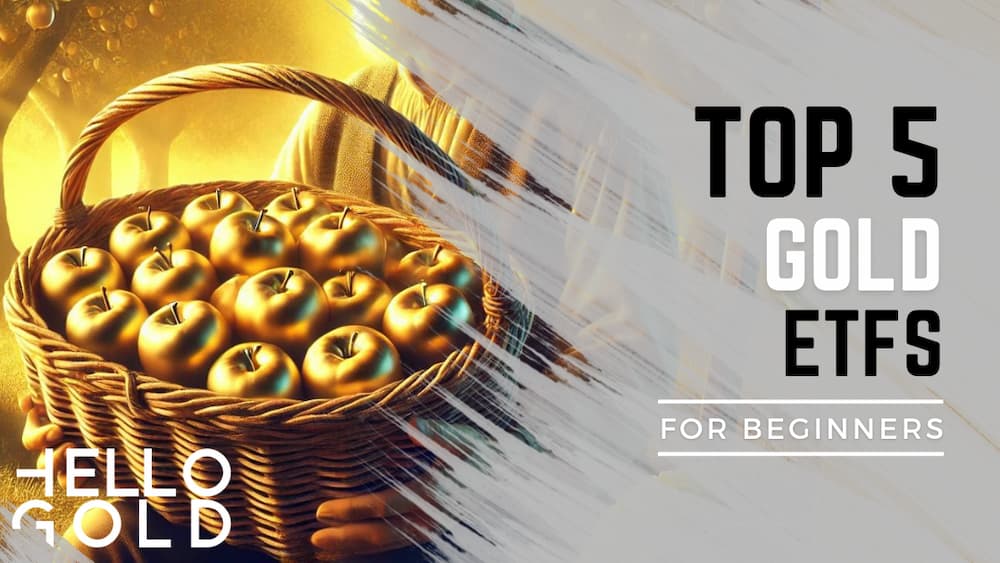You want to make your financial future more secure and diversify beyond old investments.
Gold accounts and certificates give a new way to put money into gold, mixing its long-lasting value with digital convenience.
This article explores how these new tools can make your investment portfolio stronger and more protected.
The Golden Opportunity: Understanding Gold Accounts and Certificates
Gold accounts and certificates have become new ways to invest in one of the world’s oldest and most valued commodities. These modern financial tools combine the lasting appeal of gold with the ease of digital technology, giving investors new ways to spread out their investments and protect against economic uncertainties.
Gold accounts and certificates are at the forefront of gold investment, offering a mix of traditional value and modern convenience. These financial tools provide easy access to the gold market without needing physical storage, making them especially attractive for those looking to expand their investment options.
Gold Accounts: Your Digital Treasure Chest
Gold accounts represent a big step forward in how investors interact with this timeless asset.
Unlike traditional methods of gold ownership that need secure storage and insurance, gold accounts offer a digital approach to holding and trading gold.
These accounts work similarly to regular bank accounts but deal in gold instead of currency.
Key features of gold accounts include:
- Real-time transactions: Investors can buy, sell, or trade gold at any time, providing unmatched liquidity.
- Precise ownership tracking: Holdings can be monitored down to fractions of an ounce, offering detailed portfolio management.
- Enhanced security: State-of-the-art encryption and blockchain technology ensure the safety and authenticity of holdings.
- Seamless integration: Gold accounts can be easily connected with other investments for comprehensive portfolio management.
The technology powering these accounts is advanced yet user-friendly.
Blockchain and other cutting-edge security measures ensure the authenticity and traceability of every gram of gold in an account.
This digital infrastructure allows for instant transactions, accurate ownership records, and smooth integration with existing financial systems.
When buying gold through a digital account, the transaction is recorded instantly on a secure ledger.
Investors can then monitor the value of their gold holdings in real-time, similar to stocks or other digital assets.
This level of transparency and accessibility marks a significant improvement in gold investment.
Various institutions now offer gold accounts, including traditional banks, fintech companies, and specialized precious metal firms. Each provider type has its unique advantages, and investors should carefully consider their options based on their specific needs and investment goals.
Gold Certificates: From Ye Olde Paper to Digital Gold
Gold certificates have a rich history dating back to the 17th century when goldsmiths issued paper receipts for stored gold. These certificates have undergone a significant change over time:
1865-1933: Gold certificates served as a medium of exchange in the United States, issued by the Treasury Department.
Mid-20th century: Paper certificates fell out of favor as gold ownership regulations changed.
Late 20th century: The concept was revived with modern adaptations.
21st century: Digital revolution transformed certificates into sophisticated investment tools.
Digital gold certificates represent ownership of gold stored in secure, insured vaults. Unlike their paper predecessors, these digital representations can be easily bought, sold, and transferred online, eliminating the need for physical storage and reducing associated risks.
Modern digital gold certificates offer several advantages:
- Investors can purchase gold in small quantities, making it easier for more people to invest in this asset class.
- Digital certificates can be quickly converted to cash or other assets.
- Elimination of physical storage and insurance expenses.
- Certificates can be traded from anywhere with internet access.
It’s crucial to understand the difference between allocated and unallocated gold certificates.
Allocated certificates represent specific gold bars assigned to the investor, while unallocated certificates denote ownership of a share in a gold pool.
This distinction has implications for investment risk and should be carefully considered.
An interesting historical note is that in the United States, gold certificates are still valued at a set price of $42.22 per troy ounce, even though the market price of gold is much higher. This difference highlights the evolution of gold’s role in the financial system and the importance of understanding modern gold investment vehicles.
As we move forward, the integration of gold accounts and certificates with existing financial systems continues to evolve, offering investors increasingly advanced tools for managing their gold investments. These innovations are reshaping how we think about and interact with this enduring asset, making it more accessible and manageable than ever before.
The Midas Touch: How Gold Accounts and Certificates Operate
These innovative precious metal investment options are new financial tools that are changing how people invest in precious metals. These modern methods offer an easier way to own gold, removing many of the old problems linked to physical gold investments.
Gold Accounts: As Easy as Online Banking
Gold accounts have changed precious metal investing by offering a digital way to own gold. Here’s a full overview of how they work:
Account Setup
Choosing a trusted gold account provider is very important. Look for well-known financial institutions or specialized precious metal firms with good track records.
The account opening process usually involves providing personal ID documents, proof of address, and sometimes proof of income. Be ready for Know Your Customer (KYC) procedures, which are rules designed to prevent fraud and money laundering.
Funding Options
Once your account is set up, you can add money through various methods such as bank transfer, credit card, or in some cases, cryptocurrency. This flexibility makes gold investment easier for more people.
Purchasing Gold
With most platforms, you can buy gold in amounts as small as 0.1 grams, depending on the provider.
Purchases are made at real-time market prices, with most platforms updating gold prices every few seconds to ensure current rates.
When you buy, gold is instantly added to your account.
Selling Gold
When you decide to sell, you can typically sell any amount in your account, down to very small fractions of an ounce. The sale is usually processed instantly, with money transferred to your linked bank account within 1-3 business days.
Security Measures
Gold accounts use advanced security measures to protect your investment. These include:
- Advanced encryption for account information and transaction details
- Two-factor authentication for transactions
- Regular checks to ensure the physical gold backing your account exists and matches the total of all customer holdings
- Insurance on the physical gold stored, protecting against theft or loss
Additional Features
Modern gold accounts often come with features like real-time balance tracking, the ability to set price alerts, and automatic buy/sell orders. Many providers also offer mobile apps for managing your account on the go.
Gold Certificates: Your Claim to the Yellow Metal
Gold certificates have changed a lot from their paper beginnings to today’s digital versions. Here’s a detailed look at how they work.
Types of Certificates
Traditional Certificates, these paper documents, issued by banks or financial institutions, prove ownership of a specific amount of gold held by the issuer in secure vaults.
Digital Certificates, these use blockchain technology for better security, transparency, and traceability. They can be bought, sold, or transferred electronically, offering greater liquidity than traditional certificates.
Ownership Rights
Allocated certificates represent specific, identifiable gold bars. You own particular pieces of gold, which are set aside for you.
Unallocated certificates represent a stake in a collective gold reserve. You don’t own specific gold bars, but rather a portion of the issuer’s overall gold holdings.
Obtaining Certificates
For digital certificates, the process is similar to opening a gold account.
You’ll need to create an account with a provider, complete KYC procedures, and add money to your account.
Certificates can often be purchased with minimal investment thresholds, starting from as little as 1 gram of gold.
Redeeming Certificates
Digital certificates can often be sold instantly on the platform, with proceeds swiftly deposited into your bank account.
For physical redemption (where available), you’ll typically need to request delivery of gold bars or coins matching your certificate value.
Redemption fees and processing times vary between providers and certificate types.
Verification Process
Digital certificates use blockchain for instant verification. Each transaction is recorded on a distributed ledger, ensuring transparency and reducing the risk of fraud.
Traditional certificates may require manual checking, which can take more time and potentially be less secure.
Blockchain Integration
Many modern certificate programs use blockchain to create a tamper-proof record of ownership. This technology allows for easy transfer of ownership and provides a clear audit trail.
Some platforms have even developed gold-backed cryptocurrencies that can be traded on various exchanges.
Not All That Glitters: Types of Gold Accounts and Certificates
It’s important to understand that not all gold accounts and certificates are the same. The differences between these investment options can greatly affect your financial results, making it vital to match your choice with your specific goals and how much risk you’re willing to take.
Allocated vs. Unallocated: Choosing Your Golden Path
Allocated gold accounts give you a direct claim to specific gold bars, offering a safe way to invest in physical gold without having to store it yourself.
With allocated accounts, you own particular gold bars, each identified by unique serial numbers, weights, and purity levels. Your gold is kept separate from other investors’ holdings and the institution’s assets, giving you the most protection if the institution goes bankrupt.
However, this extra security comes at a cost, with higher fees due to individual storage and full insurance costs.
On the other hand, unallocated gold accounts represent a claim on a part of a gold pool. Instead of owning specific bars, you hold a share of a larger gold holding.
Your investment becomes part of a group gold reserve, which usually results in lower storage and insurance fees.
The trade-off is more risk – should the financial institution face insolvency, you become an unsecured creditor.
The choice between allocated and unallocated accounts often comes down to individual investor preferences.
Those who want more security may prefer allocated accounts, while more cost-conscious investors might find unallocated accounts appealing.
Investors who need high liquidity for frequent trading may also prefer unallocated accounts for their flexibility.
Gold Certificate Programs: Finding Your Perfect Match
Gold certificates offer yet another way to invest in gold, with various programs catering to different investor needs.
Bank-issued gold certificates, backed by established financial institutions, often come with high minimum investment requirements and are typically aimed at wealthy individuals or long-standing customers.
These certificates offer the security of a reputable institution but may be less accessible to the average investor.
Government and mint programs present an interesting alternative.
The Perth Mint Certificate Program, for instance, is backed by the Government of Western Australia and offers both allocated and unallocated options.
This program, like many government-backed initiatives worldwide, often provides lower minimum investments compared to bank programs, making it more accessible to a wider range of investors.
In recent years, private companies have been innovating in this space with digital gold certificates. Providers like Goldmoney and BullionVault offer platforms that leverage distributed ledger systems for enhanced protection and accountability.
These digital offerings typically feature lower entry points and higher liquidity, making gold investments more accessible to more people.
When evaluating different gold certificate programs, several factors come into play.
- Minimum Investment
- Fee Structures
- Redemption Options
- Global Accessibility
Minimum investment requirements can vary greatly, from as low as $50 for some digital platforms to much higher amounts for certain bank programs.
Fee structures, particularly annual storage fees, can also differ considerably between providers.
It’s also important to consider redemption options – some programs allow for physical gold delivery, while others only offer cash settlement.
Global accessibility is another key factor, with digital platforms often providing broader access compared to traditional bank programs.
The importance of these modern investment options is highlighted by the global gold-backed ETF market, which held an impressive 3,225 tonnes of gold as of 2023. This substantial figure reflects the growing importance of gold certificates and similar products in today’s investment landscape.
Going for Gold: Integrating Accounts and Certificates into Your Investment Strategy
Adding gold accounts and certificates to your investment plan needs careful thought and smart planning. These different investments offer unique benefits, but how you use them must match your financial objectives and personal risk tolerance.
Diversification: Don’t Put All Your Eggs in One Golden Basket
Gold is a powerful tool for spreading out your investments, especially for portfolios with lots of technology stocks. History shows that when tech stocks go down, gold often keeps its value or goes up, helping to steady your overall investment performance.
As of June 2024, global gold-backed ETFs hold about 3,105 tonnes of gold, showing how important gold is in today’s investment strategies. This big number shows that investors trust gold to help diversify their portfolios and safeguard against market fluctuations.
When thinking about how much gold to add, advice varies based on your situation.
Generally, younger investors might put 5-10% of their money into gold investments. Investors close to retirement might consider putting about 10-15% of their varied portfolio into gold and gold-related stocks.
But these percentages should change based on your personal comfort with risk and financial goals. It’s important to talk to a financial advisor to figure out the best amount for your situation.
To manage your investments well, you can use tools like Personal Capital or Morningstar, which help you track gold investments along with traditional assets. These platforms can help you keep the right mix of investments and show you how your whole portfolio is doing.
It’s crucial to grasp the differences between gold ownership structures when spreading out your investments.
Allocated certificates mean you own specific gold bars, offering more security but often with higher fees.
Unallocated certificates are cheaper but riskier, especially if the company issuing them goes bankrupt.
Investors should carefully weigh these options based on how much risk they’re comfortable with and their investment goals.
Playing the Long Game vs. Quick Wins
Gold accounts and certificates work for both long-term wealth protection and short-term trading strategies.
For long-term investors, gold helps keep value and protect against inflation. Adding gold to retirement planning, with a gradual increase as you get closer to retirement, can help steady your overall portfolio.
Digital gold platforms have made it much easier to invest in and manage gold. These platforms often offer capabilities such as instant account updates, customizable market notifications, and automated trading options, helping with both long-term and short-term investment strategies.
For medium-term goals, gold-based savings plans offer an alternative to traditional savings accounts.
These plans let you add money regularly while potentially gaining from increases in gold value.
They can be especially useful for saving for big purchases or financial milestones over 5-10 years.
Short-term traders can use the easy-to-sell nature of digital gold markets for day trading or swing trading strategies.
However, it’s essential to grasp the associated risks. Short-term gold trading needs a deep understanding of market dynamics, technical analysis skills, and the ability to quickly respond to market changes.
Traders should be ready for potential losses and only use a portion of their portfolio that they can afford to risk.
To maximize returns while minimizing risks, consider these strategies:
Regular rebalancing: Keep your desired gold amount by adjusting your holdings periodically, typically every three or six months.
Dollar-cost averaging: Invest consistently over time to lessen the impact of price changes. This strategy can work well in changing gold markets.
Stay informed: Keep up with factors that affect gold prices, including economic indicators, world events, and central bank policies. Regularly check trusted financial news sources and gold market analyses.
Diversify within gold investments: Consider a mix of physical gold, gold ETFs, and gold mining stocks for a well-rounded approach. This internal diversification can help spread risk within the gold portion of your portfolio.
The Golden Rules: Regulatory Landscape and Tax Implications
The rules and tax considerations for gold-based investment options are important parts of a successful investment strategy. Understanding these elements is essential for getting the most returns and lowering risks in the gold market.
Understanding Legal Requirements
The rules for gold investments are different in various countries.
In the United States, several agencies watch over these investments, each with a specific job in protecting investors and keeping markets fair.
The Securities and Exchange Commission (SEC) and the Commodity Futures Trading Commission (CFTC) are the main regulators, enforcing strict rules to protect investors and maintain fair markets.
Internationally, standards like the London Bullion Market Association’s (LBMA) Good Delivery rules set benchmarks for quality assurance and ethical sourcing. These standards ensure the authenticity and purity of gold in the global market.
Key aspects of gold investment regulations include:
- Required Disclosures: Investment providers must be open about their operations, helping investors make informed decisions.
- Regular Audits: Periodic checks ensure that the physical gold backing investments is present and accounted for.
- Insurance Requirements: Many countries require insurance for storage facilities, providing extra protection for investors.
- Dispute Resolution Processes: These processes offer ways to resolve conflicts without expensive lawsuits.
The regulatory landscape is always changing, with potential changes coming. Upcoming laws may focus on improving transparency in the gold supply chain, potentially leading to stricter reporting requirements for gold sources.
Additionally, there’s a growing focus on strengthening anti-money laundering measures in the precious metals sector, which could result in more thorough checks for gold transactions.
While regulations provide crucial protections, they also present challenges. Compliance costs can affect investment returns, and different international standards can complicate investments across borders.
Investors should stay informed about regulatory changes and consider their effects when making investment strategies.
Tax Implications for Gold Investments
How gold investments are taxed can significantly impact overall returns. In the United States, the Internal Revenue Service (IRS) classifies physical gold and certain gold certificates as collectibles, which has specific tax implications:
- Capital Gains: Long-term capital gains on collectibles, including qualifying gold investments, are taxed at a maximum rate of 28%. This rate is higher than the 15% or 20% rate that applies to most other long-term investments.
- Interest Income: For gold accounts that generate interest, the interest is typically taxed at ordinary income tax rates, which can be as high as 37% for high-income earners.
- Reporting Requirements: Most gold transactions must be reported on Form 1099-B, which tracks cost basis and sales price for tax calculation purposes.
International investors face additional complexities, needing to navigate local reporting standards and potential double taxation issues. Understanding applicable tax treaties is crucial for optimizing international gold investments.
Strategies for tax-efficient gold investing include:
Gold IRAs: These specialized precious metals Individual Retirement Accounts allow investors to hold certain gold investments while benefiting from IRA tax advantages. This can result in tax-deferred growth (traditional IRA) or tax-free growth (Roth IRA).
Strategic Timing: Carefully planning when to buy and sell can help manage tax liabilities. Holding investments for over a year to qualify for long-term capital gains rates is a common strategy.
Tax-Loss Harvesting: Offsetting capital gains with capital losses from other investments can help minimize overall tax burden.
The importance of understanding these tax implications is highlighted by the size of the global gold market. As of June 2024, gold-backed ETFs across the globe collectively manage approximately 3,105 tonnes of the precious metal, representing a substantial portion of investment portfolios worldwide.
It’s important to note that tax laws are complex and subject to change. While this overview provides a foundation, consulting with a qualified tax professional is crucial for developing a tax strategy tailored to individual circumstances.
In Conclusion
Gold accounts and certificates give you new ways to invest in gold. They mix gold’s stability with easy-to-use digital tools. You can spread out your investments and protect against money troubles.
Start by looking into well-known companies that offer these services. Understand the differences between types of accounts to choose what’s best for you. Think about how gold fits with your other investments.
Talk to a financial expert to make sure gold investing matches your goals and comfort with risk. These new gold options can help make your money more secure for the future.











